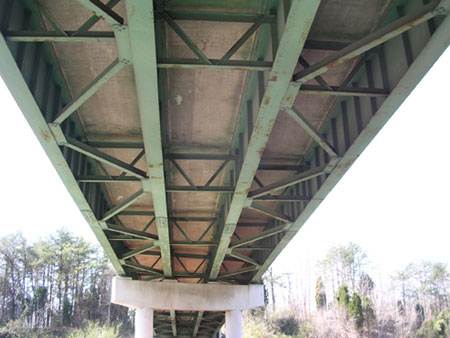U.S. Department of Transportation
Federal Highway Administration
1200 New Jersey Avenue, SE
Washington, DC 20590
202-366-4000
Focus
| Accelerating Infrastructure Innovations |
Publication Number: FHWA-HRT-07-017
Date: September 2007
A new steel bridge testing initiative launched by the Federal Highway Administration (FHWA) aims to improve the safety of the Nation's steel bridges by using nondestructive evaluation (NDE) technology to detect growing cracks in bridges, including subsurface flaws as small as 0.025 cm (0.010 in) in length or depth. With steel bridges representing approximately 34 percent of the nearly 600,000 highway bridges in the United States, reliable inspection, condition assessment, and early detection and isolation of any pertinent deterioration are vital to improving the safety of these structures.
The primary failure mechanism in steel bridges is metal fatigue. Fatigue failures in structural components of steel bridges are due to repetitive dynamic loadings, also known as "fatigue loadings." The process of metal fatigue begins with tiny fatigue cracks caused by the constant movement of car and truck traffic over bridges. These cracks usually initiate at the fatigue prone areas of the bridge, including the connections, attachments, and details, such as welds in steel girders. The cracks grow under repetitive loads until they can reach a critical size and eventually cause structural failure. Fatigue failure is particularly dangerous because it can occur without any obvious prior warnings.
There are a number of tools and technologies currently in use to locate fatigue cracks in steel bridge members. However, most of them provide limited information or are difficult to use in regular bridge inspection practice. The overarching objective of the new program is to significantly raise the bar on the level of technology available to bridge owners and the level of information that is provided to them so that they can make appropriate decisions regarding needed repairs. For example, most technologies available today require a lot of surface preparation (e.g., grinding off paint and rust). And although current technologies can identify whether a crack exists or not, or possibly indicate the size of the crack, no technologies currently available can fully characterize the crack (including location, size, orientation, whether the crack is actively growing, and most importantly, how fast the crack is growing). This is the ultimate objective of the Steel Bridge Testing Program.
The new testing program was authorized under the 2005 Safe, Accountable, Flexible, Efficient Transportation Equity Act: A Legacy for Users (SAFETEA-LU). The initiative will have three phases. Phase one will identify both commercial and developmental NDE technologies that can detect fatigue cracks in steel bridges. "Both crack detection technologies and technologies to detect and monitor crack growth are of equal interest," says Frank Jalinoos of FHWA. In phase two, the selected technologies will be tested and evaluated under a controlled environment in the FHWA NDE Center laboratory at the Turner-Fairbank Highway Research Center in McLean, Virginia, to assess the capabilities and limitations of each technology. In phase three, the prospective NDE technologies will be deployed and tested to assess their functionality in field applications.
As part of the initiative, an informational database will also be developed that will include current commercial, state-of-the-art, developmental, and prototype bridge inspection technologies and their associated capabilities. "This Web-based database will be available to State departments of transportation and other stakeholders to help meet their bridge inspection, evaluation, and safety needs," says Jalinoos.
Several prospective NDE technologies have been selected by FHWA as part of phase one. The next step in the initiative will be to procure or lease the selected NDE products for laboratory and field test evaluations. FHWA is also considering advertising a Broad Agency Announcement as part of phase one, which will solicit developmental products or system prototypes.
For more information on crack detection in steel bridges or the FHWA steel bridge testing program, contact Frank Jalinoos at FHWA, 202-493-3082 (email: frank.jalinoos@fhwa.dot.gov), or the NDE Center's Senior Research Engineer contractor, Ali Rezai, at 202-493-3119 (email: ali.rezai@fhwa.dot.gov). Information is also available online at www.fhwa.dot.gov/publications/research/nde/01020.cfm.
 |
| A view of typical connections, attachments, and details in steel bridges. |